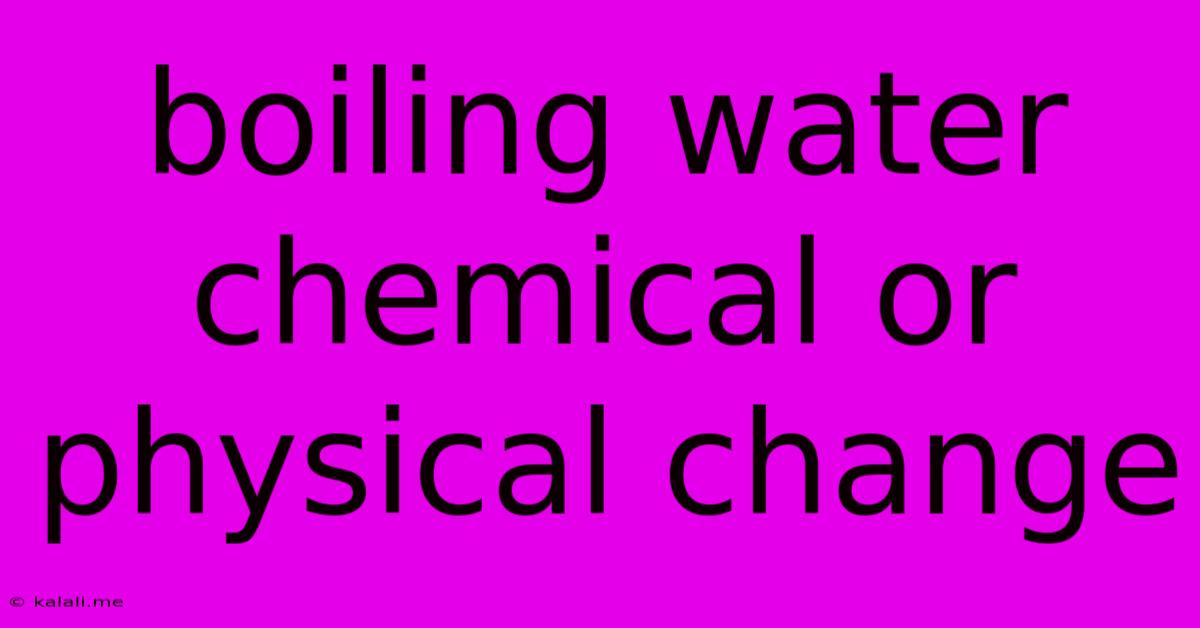Boiling Water Chemical Or Physical Change
Kalali
May 10, 2025 · 3 min read

Table of Contents
Boiling Water: A Physical Change Explained
Is boiling water a chemical or physical change? This seemingly simple question often trips up students and even adults. The short answer is: boiling water is a physical change. This article will delve into the reasons why, exploring the key differences between physical and chemical changes and examining the process of boiling water in detail. Understanding this distinction is crucial for grasping fundamental scientific concepts.
Boiling water involves a change in the state of matter, from liquid to gas (water vapor or steam). This transformation is reversible; you can condense the steam back into liquid water. This reversibility is a key indicator of a physical change. Let's explore the specifics:
Understanding Physical and Chemical Changes
Before diving into the specifics of boiling water, it's important to clarify the core differences between physical and chemical changes.
-
Physical Changes: These changes affect the form or appearance of a substance but don't alter its chemical composition. Examples include melting ice, dissolving sugar in water, and, as we'll see, boiling water. The substance remains the same; only its physical state or form changes.
-
Chemical Changes: These changes result in the formation of new substances with different chemical properties. Examples include burning wood (producing ash and gases), rusting iron, and baking a cake. The original substances are transformed into entirely new ones.
The Science Behind Boiling Water
When you boil water, you're adding energy in the form of heat. This energy increases the kinetic energy of the water molecules, causing them to move faster and faster. At the boiling point (100°C or 212°F at standard atmospheric pressure), the molecules have enough energy to overcome the intermolecular forces holding them together in the liquid state.
This allows them to transition into the gaseous state (steam), escaping the liquid as bubbles. Crucially, the water molecules themselves haven't changed; they're still H₂O. The only change is their arrangement and state of matter. This is why it's classified as a physical change.
Distinguishing Features of a Physical Change in Boiling Water
Several characteristics highlight the physical nature of the boiling process:
- Reversibility: As mentioned earlier, boiling is reversible. Condensing the steam back into water demonstrates this.
- No new substance formed: The chemical composition remains H₂O throughout the entire process.
- Change in state only: The change is limited to a transition from liquid to gas; no new chemical compounds are created.
- Observable changes: You can easily observe the change in state (liquid to gas), the formation of bubbles, and the increase in temperature.
Common Misconceptions
It's important to address some common misconceptions:
- Bubbles are not a new substance: The bubbles are simply water vapor, a different state of the same substance.
- Temperature change is not a chemical reaction: A temperature increase indicates a change in energy, not a fundamental alteration of the molecules themselves.
Conclusion
In conclusion, boiling water is definitively a physical change. The process involves a change in state from liquid to gas, but the chemical composition of the water remains unchanged. Understanding this distinction helps build a solid foundation in understanding fundamental scientific principles. Remembering the key characteristics of physical changes – reversibility, absence of new substance formation, and change in state – will help you classify similar processes accurately.
Latest Posts
Latest Posts
-
What Year Would I Be Born If I Was 17
Jul 15, 2025
-
What Is Longer A Kilometer Or A Mile
Jul 15, 2025
-
How Much Does A Full 15 Lb Propane Tank Weigh
Jul 15, 2025
-
Did Chester Wear A Brace On Gunsmoke
Jul 15, 2025
-
How Many Mikes Hard To Get Drunk
Jul 15, 2025
Related Post
Thank you for visiting our website which covers about Boiling Water Chemical Or Physical Change . We hope the information provided has been useful to you. Feel free to contact us if you have any questions or need further assistance. See you next time and don't miss to bookmark.